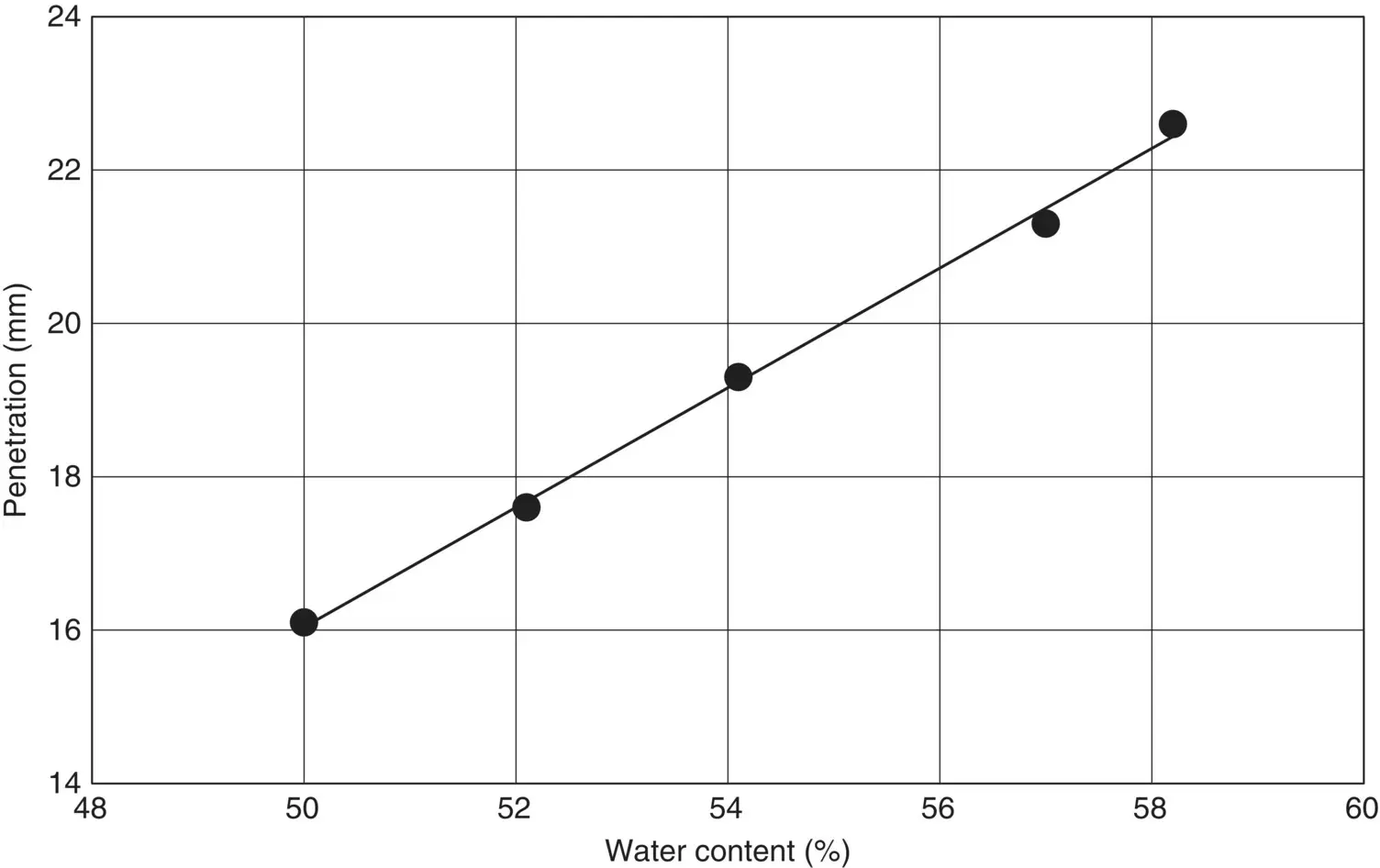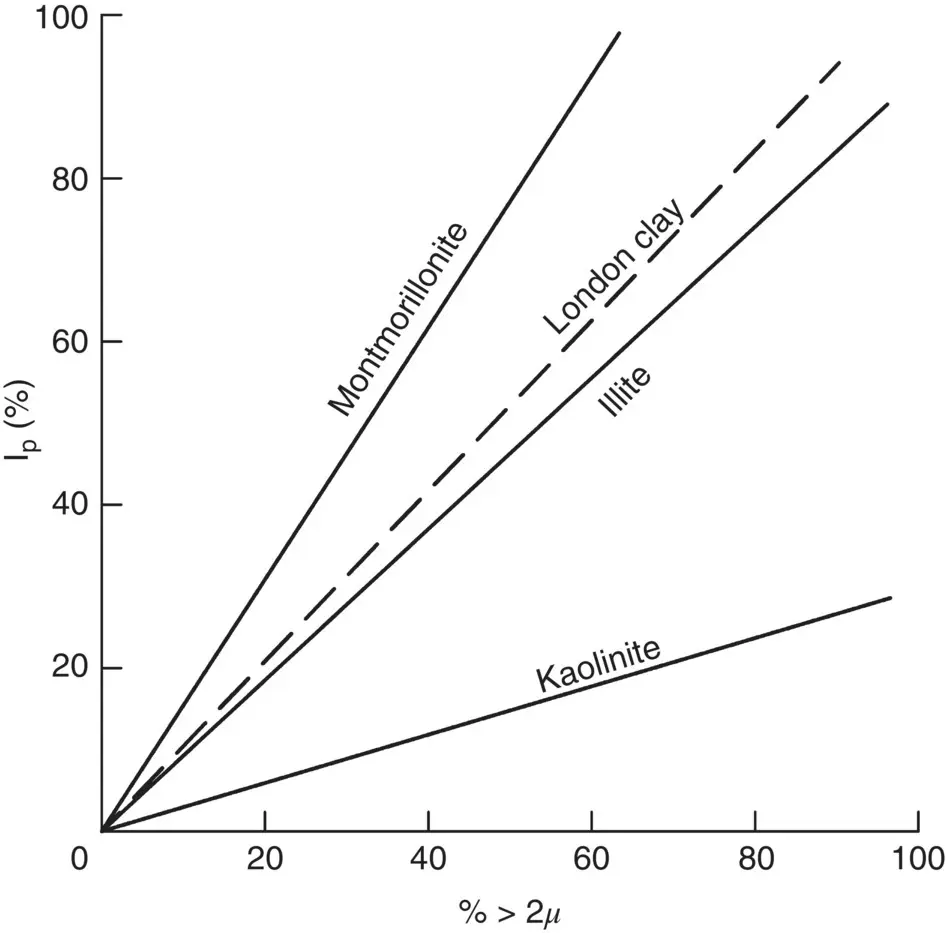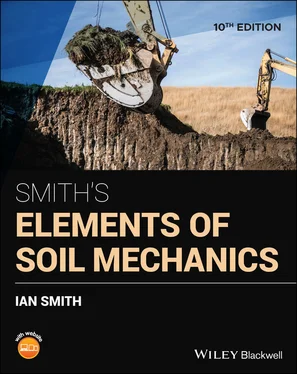2 Casagrande apparatusAlthough still used worldwide, the Casagrande test has now been largely superseded by the fall cone method because the latter achieves more repeatable results. In the UK, the fall cone test is adopted as the first‐choice test method.
About 20 g of soil prepared as in the liquid limit test is used. The soil is mixed on the glass plate with just enough water to make it sufficiently plastic for rolling into a ball, which is then rolled out between the hand and the glass to form a thread. The soil is judged to be at its plastic limit when it just begins to crack at a thread diameter of 3 mm. At this stage, several pieces of the thread are taken for water content determination. The test is repeated until two water content tins contain an adequate mass of soil threads – approximately 10–15 g in each tin.
It is interesting to note that in some countries, the fall cone penetrometer is used to determine both w Land w P. The apparatus uses a 30° angle cone of mass 76 g. The procedure is the same as the fall cone described above, only this time w Lis taken at a penetration of 17 mm and w Pis taken as the water content at a penetration of 2 mm.
Example 1.4Consistency limits tests
A cone penetrometer test was carried out on a sample of the clay from Example 1.3, with the following results:
| Cone penetration (mm) |
16.1 |
17.6 |
19.3 |
21.3 |
22.6 |
| Water content (%) |
50.0 |
52.1 |
54.1 |
57.0 |
58.2 |
The results from the plastic limit test were:
| Test no. |
Mass of tin (g) |
Mass of wet soil + tin (g) |
Mass of dry soil + tin (g) |
| 1 |
8.1 |
20.7 |
18.7 |
| 2 |
8.4 |
19.6 |
17.8 |
Determine the liquid limit, plastic limit and the plasticity index of the soil.
Solution:
The plot of cone penetration to water content is shown in Fig. 1.7. The liquid limit is the water content corresponding to 20 mm penetration, i.e. w L= 55%.

Fig. 1.7 Example 1.4.
The plastic limit is determined thus:

The plasticity index is the difference between w Land w Pi.e.

In addition to their use in soil classification, the w Land w Pvalues of a plastic soil also give an indication of the types and amount of the clay minerals present in the soil.
It has been found that, for a given soil, the plasticity index increases in proportion to the percentage of clay particles in the soil. Indeed, if a group of soils is examined and their I Pvalues are plotted against their clay percentages, a straight line, passing through the origin, is obtained.
If a soil sample is taken and its clay percentage artificially varied, a relationship between I Pand clay percentage can be obtained. Each soil will have its own straight line because, although in two differing soils the percentages of clay may be the same, they will contain different minerals.
The relationship between montmorillonite, illite, kaolinite and the plasticity index is shown in Fig. 1.8. The plot of London clay is also shown on the figure and, from its position, it is seen that the mineral content of this soil is predominantly illite. London Clay has a clay fraction of about 46% and consists of illite (70%), kaolinite (20%) and montmorillonite (10%). The remaining fraction of 54% consists of silt (quartz, feldspar and mica: 44%) and sand (quartz and feldspar: 10%). In Fig. 1.8, the slope of the line is the ratio:

Fig. 1.8 Relationship between I Pand clay percentage.
Modified from Skempton (1953).

Skempton (1953) defined this ratio as the activity of the clay. Clays with large activities are called active clays and exhibit plastic properties over a wide range of water content values.
1.6 Soil classification and description
1.6.1 Soil classification
Soil classification systems have been in use for a very long time with the first recorded use being in China over 4000 years ago. In 1896 a soil classification system was proposed by the Bureau of Soils, United States Department of Agriculture in which the various soil types were classified purely on particle size and it is interesting to note that the limiting sizes used are more or less the same as those in use today. Further improved systems allowed for the plasticity characteristics of soil, and a modified form of the system proposed by Casagrande in 1947 was the basis of the soil classification system used in the UK for many years. With the widespread adoption of BS EN ISO 14688:2018 (BSI, 2018a,c), the classification of soils across Europe now follows a standardised approach.
In order to classify soils, the system considers natural soils as falling into one of the following categories: very coarse , coarse , fine and organic . The majority of soils are inorganic, and particle sizes and plasticity characteristics of these soils are used to identify the primary soil fraction . Developing the notion of fraction sizes listed in Table 1.1, BS EN ISO 14688‐2:2018 (BSI, 2018c) offers the principles of classification listed in Table 1.3.
Since soils are usually composite (i.e. contain various amounts of different particle sizes) it will be the case that secondary and tertiary fractions will also exist in the soil. In soil classification and description, these additional fractions are used as adjectives and the primary fraction is the noun. The primary fraction is written in capitals: e.g. sandy, silty CLAY; gravelly, coarse SAND; clayey SILT.
For fine soils, the results of the liquid and plastic limits tests are used to classify these soils. Classification is done through the use of a plasticity chart ( Fig. 1.9). To use the plasticity chart, a point is plotted whose coordinates are the liquid limit and the plasticity index of the soil. The soil is then classified by observing the position of the point relative to the sloping straight line drawn across the diagram. This line, known as the A‐line , is an empirical boundary between inorganic clays, whose points lie above the line, and organic silts and clays whose points lie below. The A‐line goes through the base line at (w L= 20%, I P= 0) so that its equation is:
Table 1.3 Principles of soil classification.
| Soil group |
Primary function |
Criteria |
| Very coarse |
Boulders (Bo) |
50% of particles >200 mm in size |
|
Cobbles (Co) |
200 mm > 50% > 63 mm |
| Coarse |
Gravel (Gr) |
63 mm > 50% > 2 mm |
|
Sand (Sa) |
2 mm > 50% > 0.06 mm |
| Fine |
Silt (Si) |
Low plasticity or non‐plastic |
|
Clay (Cl) |
Plastic |

Fig. 1.9 (a) Plasticity chart based on BS 5030 (BSI, 2015) (b) Plasticity chart based on BS EN ISO 14688‐2 (BSI, 2018c).
Читать дальше


















